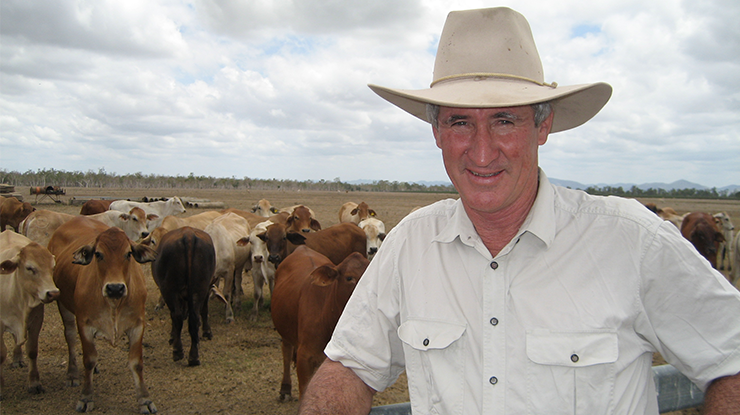
Don, Laurel, Peter and Scott Heatley run 8,000 head in an integrated breeding and fattening operation across 27,000ha in north Queensland. They have developed 500ha of leucaena under flood irrigation on ‘Byrne Valley’, 44km south of Home Hill.
“Initially we were hesitant about planting leucaena as we were cattle producers not farmers,” Don said.
However, after inspecting irrigated leucaena pastures in the Ord River Irrigation Area at Kununurra, he was convinced that irrigated leucaena was the intensive fattening system that his operation needed.
Establishment
Their first leucaena paddock, a converted rice paddy, was planted in 1998. Soils are sandy loams on the river levee and heavy cracking clays on the flood plain. Most paddocks are about 80ha (2000m long x 400m wide) and were laser-levelled with a fall of 0.1%. A deep V-shaped furrow maintains fast irrigation water flow with cv. Cunningham leucaena planted in twin rows on the raised beds 4m apart.
Leucaena is planted during the early dry season (late April/early May) under irrigation. Wet season plantings have failed because, under heavy rainfall, soil crusting prevented seedling emergence. Weeds are controlled with selective herbicide applications (usually twice) as cultivation is not possible on the wet clay soils. Rhodes grass has colonised the interrows.
Irrigation
Originally every inter-row was flood irrigated from two pumps lifting water (150 L/s) from the adjacent Burdekin River. Now irrigation water is applied to every second inter-row as a fast flush on an alternating basis. This has improved water use efficiency (halved water and power usage) whilst maintaining forage production.
Leucaena paddocks are irrigated immediately after grazing and each paddock typically receives 4–5 applications per year delivering a total of 4–5 ML/ ha/yr depending upon rainfall. Furrows are delved every four years to maintain consistent fast water flow.
Management
Maintenance fertiliser (44 kg/ha P and 55 kg/ha S) is applied every 4–5 years. Psyllids cause significant damage periodically and future plantings will use psyllid-tolerant cv. Redlands. Despite intensive rotational grazing, hedgerows have to be cut back every 4–5 years. Cattle are removed from the leucaena paddocks during the wet season to avoid pasture damage and graze adjacent improved stylo/grass pastures.
Paddocks are rotationally grazed during the dry season only (April-November) at an effective stocking rate of >20 livestock unit AE/ha. The leucaena is spelled for 5–6 weeks before being grazed again.
The Heatleys produce Rhodes grass hay which is fed ad lib as a source of roughage with cattle eating about 5 kg/hd/day. Molasses is fed (2 kg/hd/d) as an energy supplement.
Production and marketing
Growth rates are 0.9–1.4 kg/day totalling a live weight gain of 1000kg/ha/yr from the leucaena pastures.
Steers are sold direct to meat processors supplying export markets in Japan, Korea and USA at 630–670kg live weight (340–360kg carcase weight) at 24–26 months of age. This leucaena feeding system has halved the age to turn-off compared with grass-only pastures.
The quality of the finished cattle has improved giving the Heatleys flexibility to target premium markets. The irrigated pastures have enabled finished cattle to be sold throughout the dry season when supply is short and prices high. Irrigation has also reduced the impact of seasonal conditions on production, guaranteeing income and profit security.
Lessons learnt
Despite many challenges, the Heatleys have developed a method of establishing leucaena under flood irrigation. Lessons learnt include:
- deep-rip ground under beds before planting
- do not plant in the wet season
- do not plant seed too deep
- keep grass competition away from young leucaena
- maintain a consistent irrigation schedule (do not rely on rainfall)
- maximise leucaena production within the irrigated area; provide roughage (grass or hay) and energy supplements outside the paddock
- always locate stock water for cattle outside leucaena paddocks.
Future plans
The Heatleys plan to develop another 800ha of irrigated pasture, planting cv. Redlands and reducing inter-row spacing to 2m to maximise leucaena production and control shrub height. Water will be delivered by an underground pipe network rather than through fluming.








